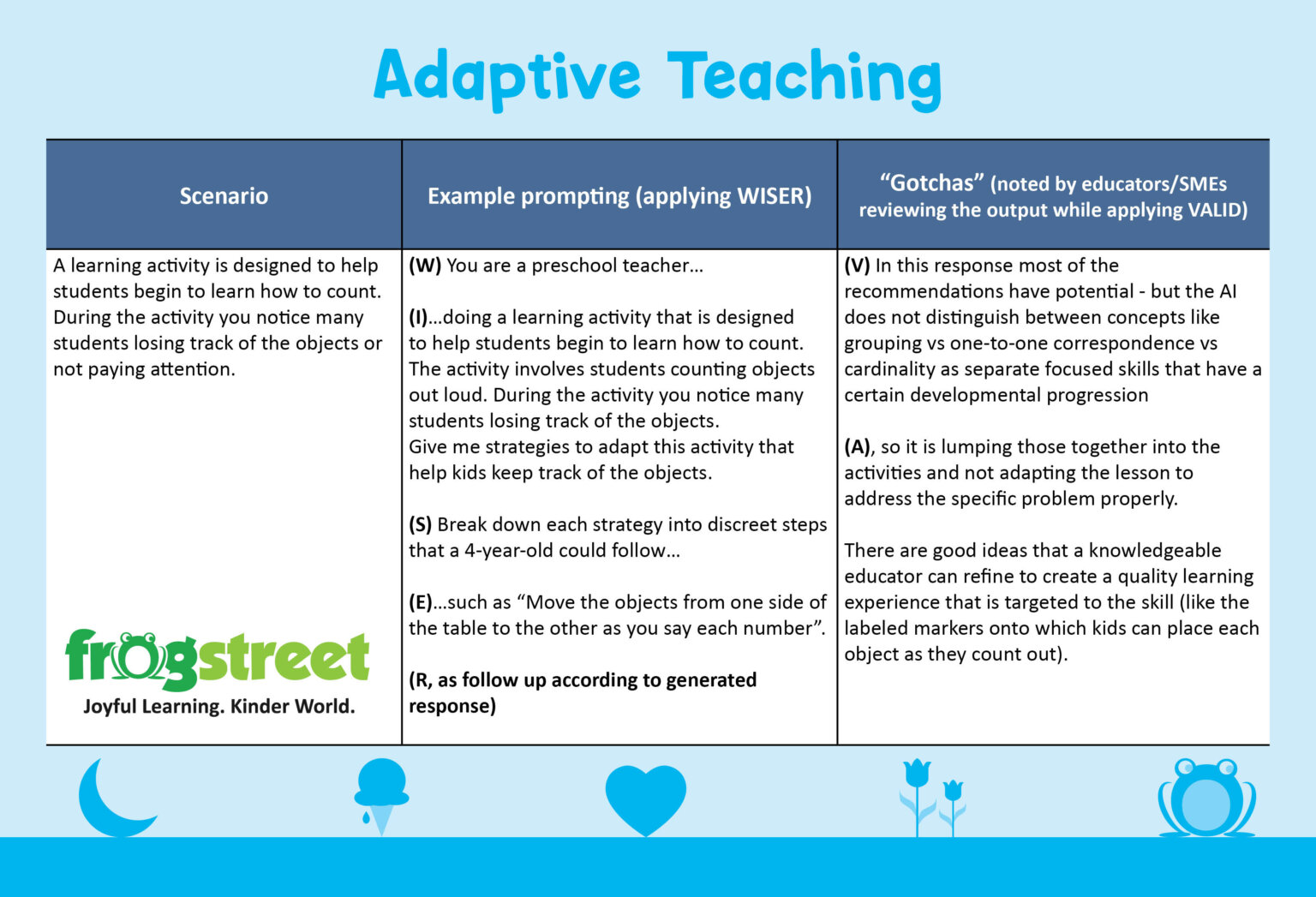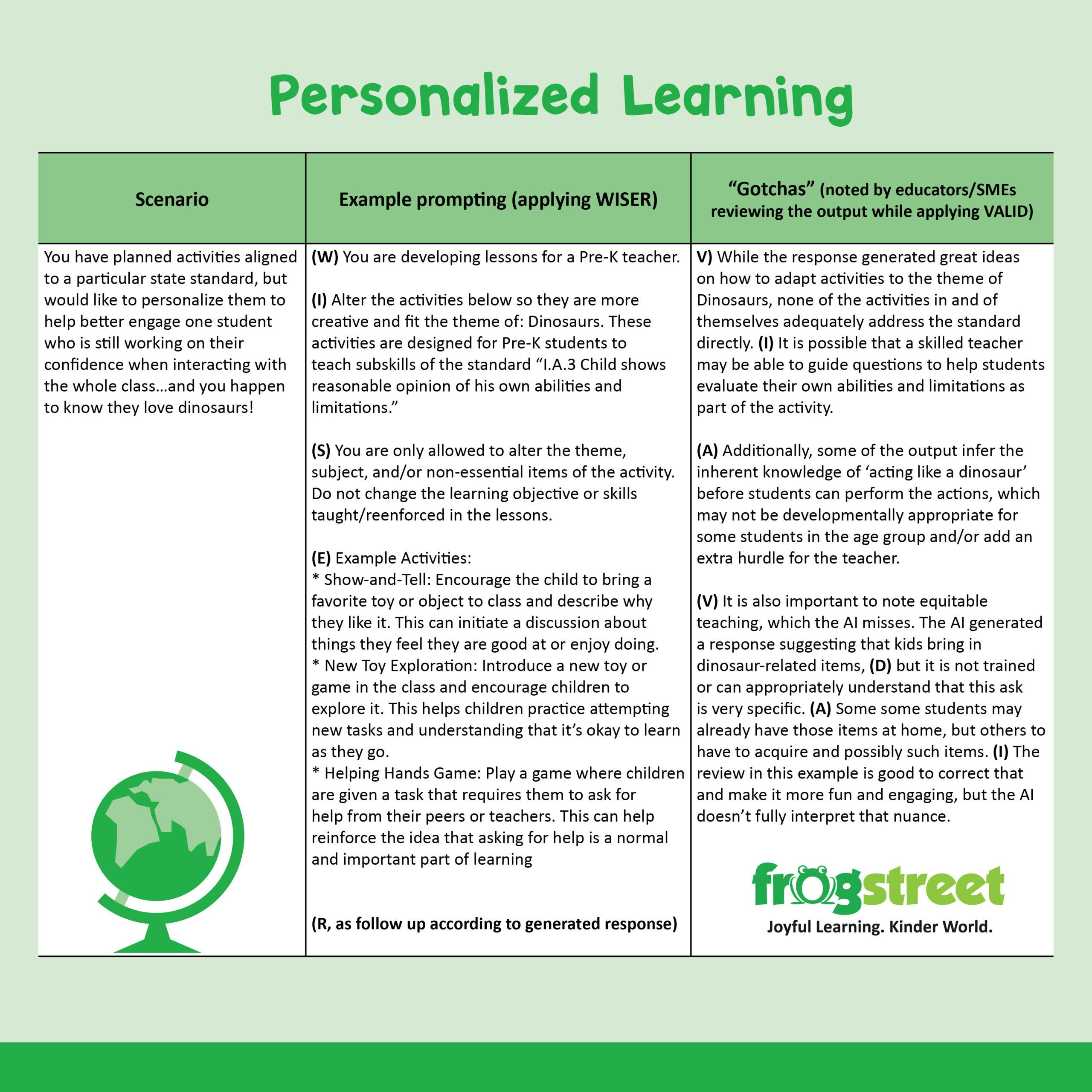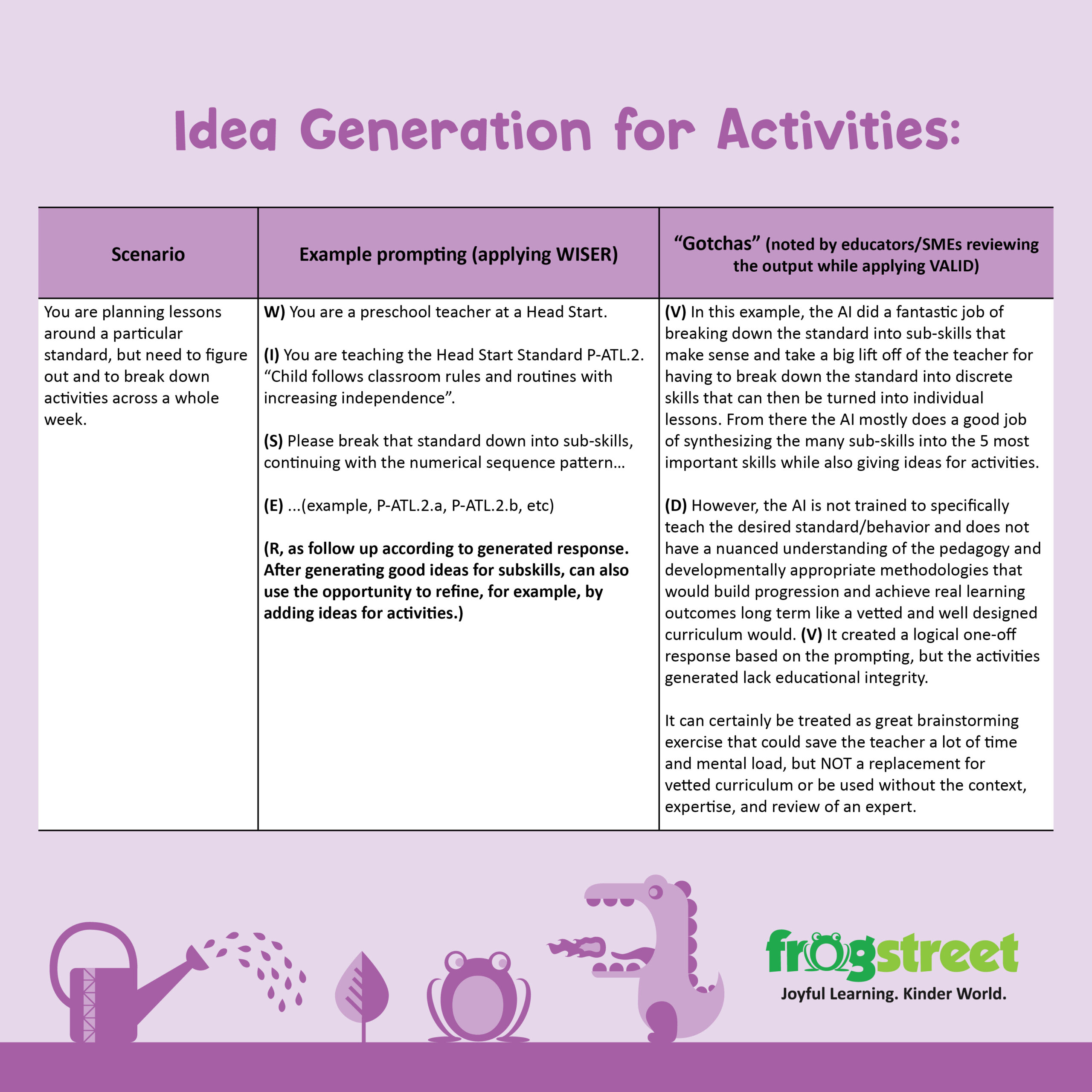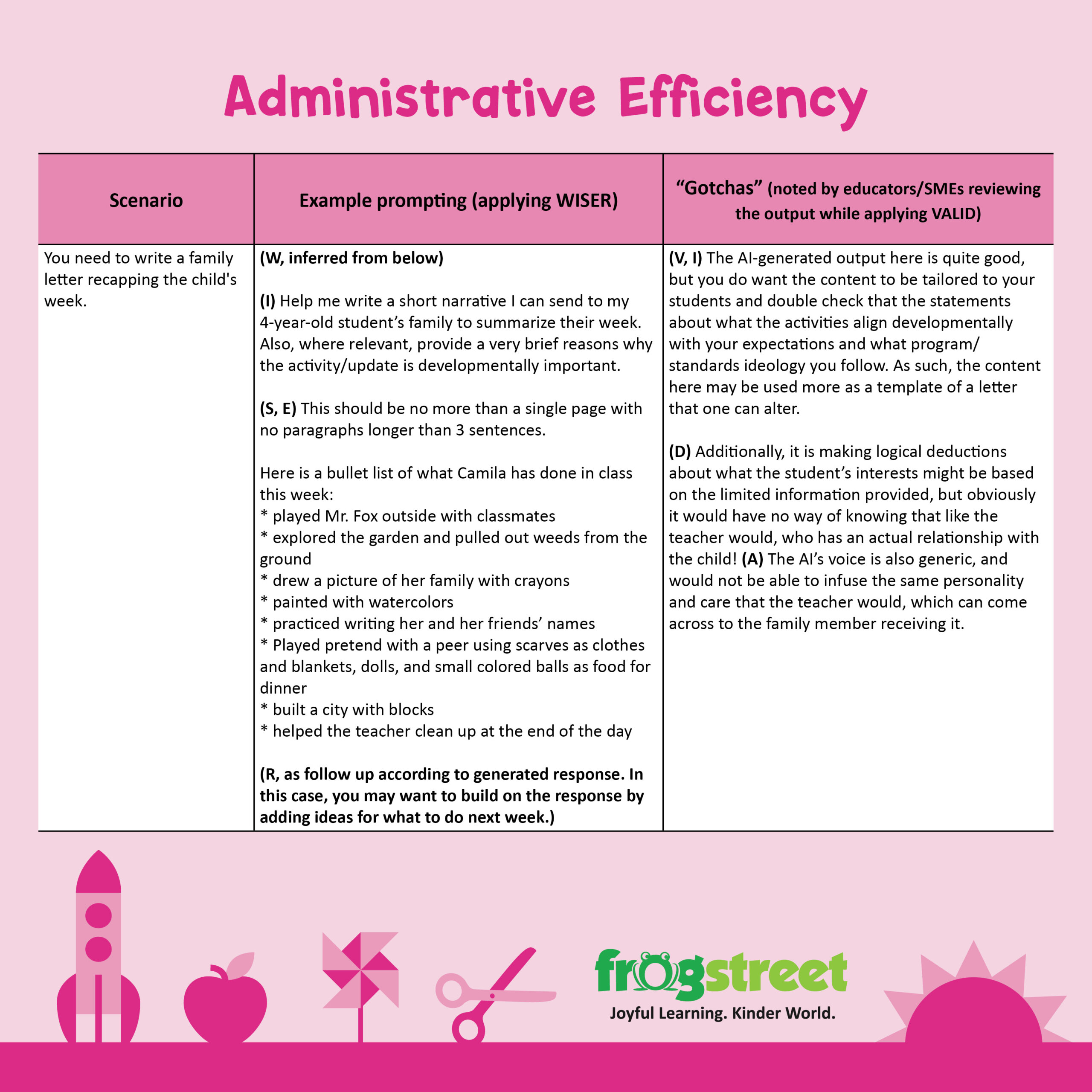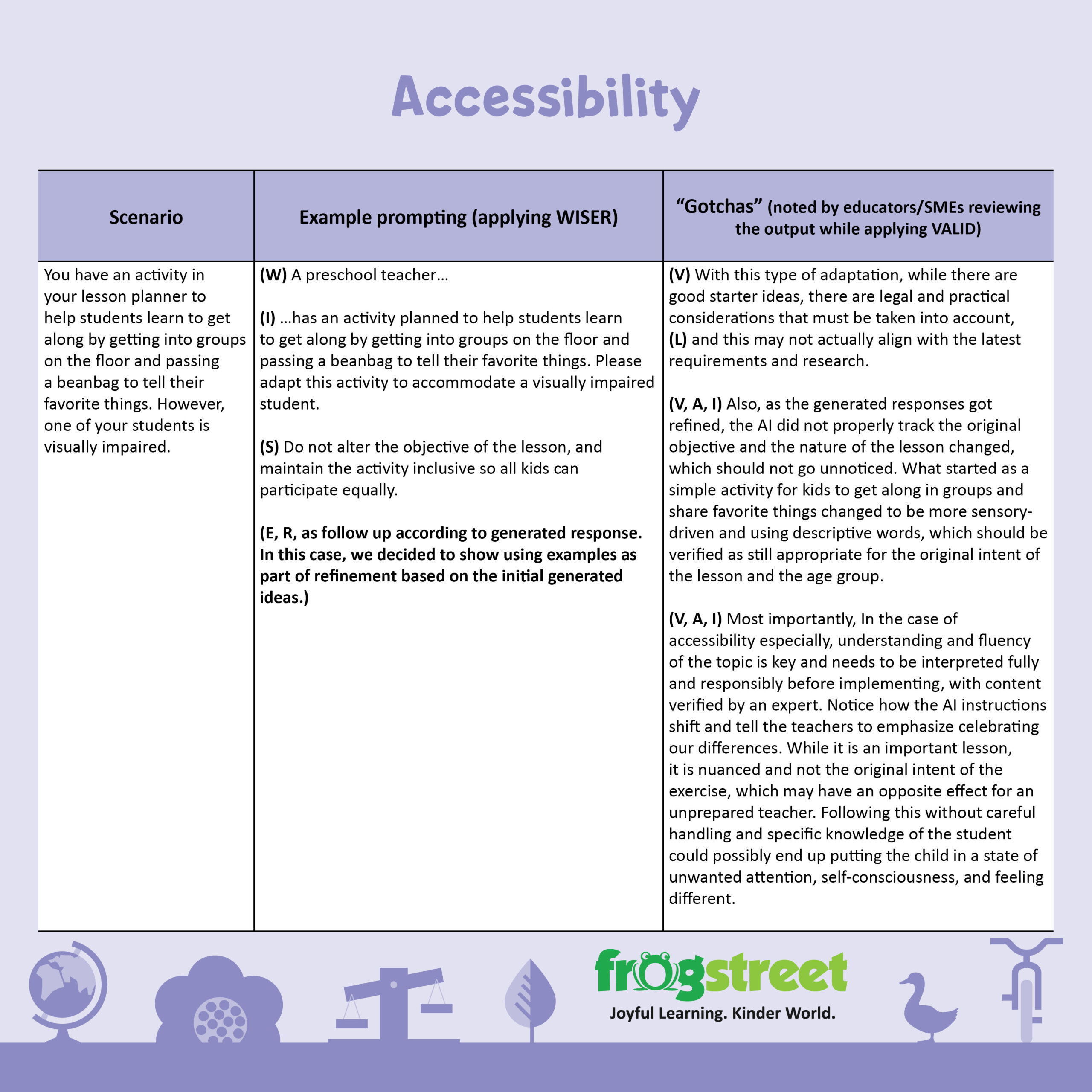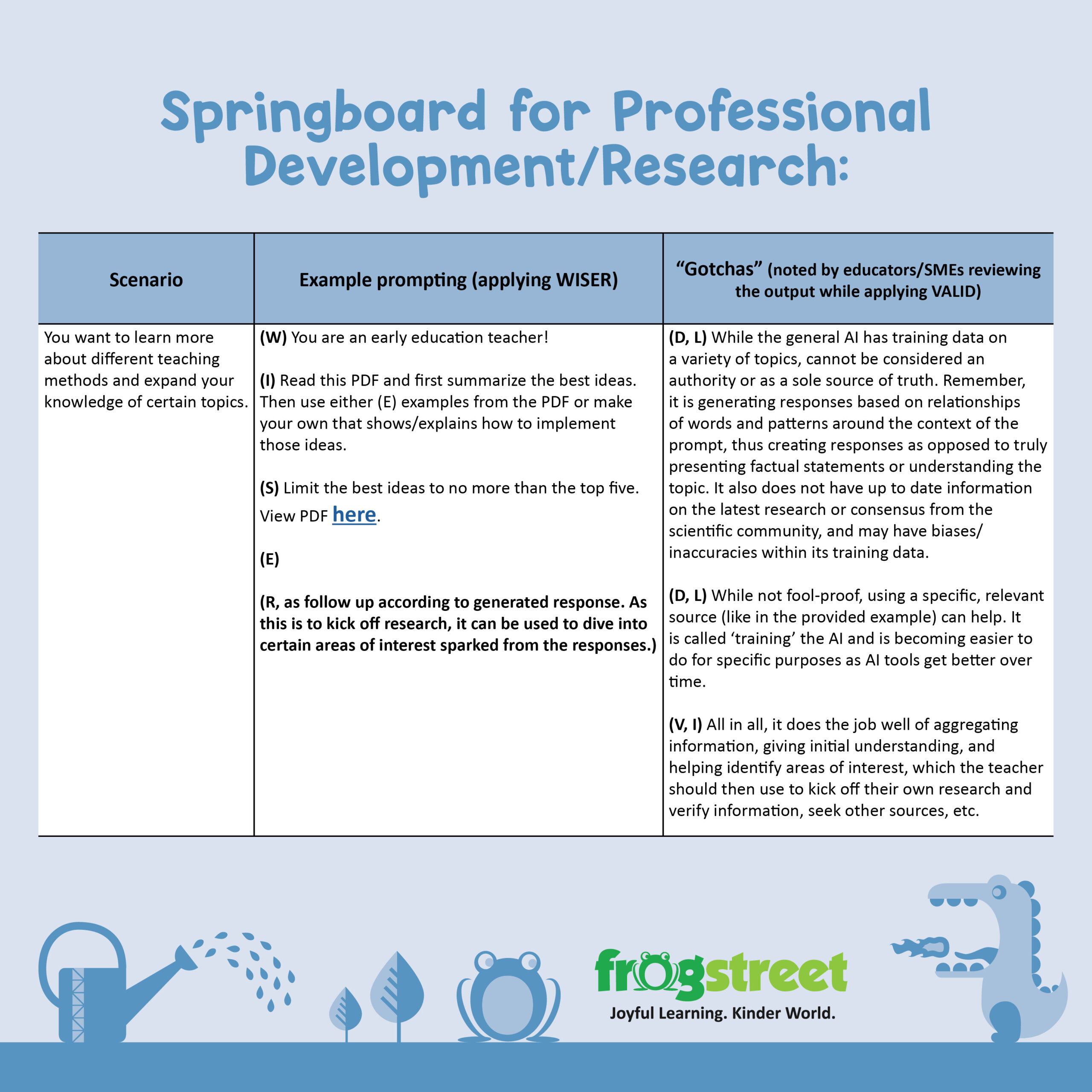April 2, 2024 / AI Blog
AI In Education: Examples to Apply Your Knowledge
From personalized learning experiences for students to streamlining administrative tasks for educators, artificial intelligence (AI) is transforming education in classrooms worldwide.
Today, we are here to share some real-life AI in education examples that showcase the transformative power of AI in enhancing teaching and learning outcomes for early childhood educators.
Table of contents:
- WISER and VALID Methodology
- What to consider when engaging with AI in education examples
- AI in Education Examples
- Personalized Learning
- Idea Generation for Activities
- Administrative Efficiency
- Accessibility
- Springboard for Professional Development/Research
WISER and VALID Methodology
The key to using artificial intelligence effectively within an educational setting is knowing what prompts to use to generate the best responses from AI tools like ChatGPT. Teachers looking to integrate AI software into their classrooms seamlessly should employ the WISER method when prompting AI tools and following these AI in education examples.
Created by artificial intelligence advisor Abbie Miller, the WISER method uses the following framework:
🗣️ W – Who is it?
Start your prompt by explaining who you are in the scenario. Begin your prompt with “You are a ____.” You are a creative literature expert. You are a marine biologist. You are a ballet dancer who breaks the rules. Give yourself an identity and environment.
✏️ I – Instructions
Provide clear instructions for the software you are utilizing. What do you want the AI model actually to do? If creating a prompt for a creative literature expert, instruct the model to explain the plot of a novel in simple terms briefly. Ensure your instructions are explicit and easy for the model to understand.
✂️ S – Sub Tasks
Break tasks down into smaller pieces to improve the AI’s performance. Helping the model “think” step by step can help ensure you get the desired results.
🖼️ E – Examples
Artificial intelligence excels at mimicry, so help it by providing examples or a template to follow. If you want to write a poem, give an example poem. If you wish to do a dance routine, describe a move to start from. Multiple, varied AI in education examples are best.
📖 R – Review
Is the output what you wanted? Did it fall short? Do you have a next step? Use the chat interface to your advantage; ask follow-up questions, clarify, or expand on ChatGPT’s initial response. Ask it to be funnier, longer, or more direct in tone. Don’t be afraid to start over or start a new chat thread.
What to consider when engaging with AI in education examples
As responsible educators, some key elements to consider when using AI in the classroom include:
- Carefully evaluate AI tools for safety, privacy, and age-appropriateness before adopting them.
- Using AI thoughtfully as a complement to, not a replacement for, skilled human teachers. The teacher must remain the heart of the classroom.
- Looking for bias in data/algorithms and ensuring AI does not inherit harmful stereotypes.
- Giving transparency into how AI applications work so teachers and students can develop informed views.
Feeling overwhelmed? Don’t panic! We know that evaluating AI for use in education can be overwhelming; luckily, Frog Street created a simple acronym to help you think about and validate these things: VALID
- Verified – Can I verify the output using other sources?
- Appropriate – Is the information safe and proper for everyone in my classroom?
- Latest – Is the information current and up to date?
- Interpretable – Can I fully interpret how the output arrived at this conclusion?
- Data – Has the AI been trained with proper educational texts and materials suitable for children?
Consider this a starter set of guiding questions to ask yourself when using AI tools and their output.
Below, this guide will explore some benefits of using AI tools in the classroom and share AI in education examples demonstrating how employing the WISER and VALID methods can help you achieve the best possible results when incorporating AI tools into your curriculum.
We will introduce scenarios within larger themes, generate outputs following the WISER framework, and apply the VALID guide to identify areas of caution where possible refinement, adjustments, or additional/alternative sources may be needed.
Remember, the purpose here is not for you to take the example verbatim or to make any claims about specific activities/generated output you should or shouldn’t use in your classroom but to treat this as applied “practice” so that you can incorporate it in your day-to-day responsibly and with more confidence! Ready? Here we go!
AI in Education Examples
Adaptive Teaching
AI can help you adjust teaching methods and pace on the fly based on real-time feedback on how well children understand concepts. If they are bored or struggling, it changes things to engage them better.
Adaptive efficiency generated response
Personalized Learning
AI applications can analyze students’ abilities, strengths, weaknesses, interests, and learning styles to create a customized curriculum and learning activities. This allows teachers to support each child’s unique needs.
Personalized learning generated response
Idea Generation for Activities
Generative AI emerges as a powerful tool for brainstorming and crafting innovative learning experiences. With defined parameters and guidelines, it generates activity ideas tailored to specific educational standards and classroom needs, offering teachers a wealth of possibilities to enhance their lessons.
Idea generation for activities generated response
Ultimately, Generative AI complements teachers’ creativity and saves time in lesson planning, but it cannot replace the expertise and review of educational professionals. Its outputs should be used as a starting point, requiring contextual knowledge and expert scrutiny to translate into practical learning experiences.
Administrative Efficiency
AI-powered software can help with routine tasks like grading, record-keeping, communication with parents, and organizing events. This saves teachers valuable time and mental energy.
Administrative efficiency generated response
*NOTE: This example follows WISER, but we wanted to show it in a bit more of an “advanced” way that adapts it to fit the context better without adding extra work as the prompter, just so you have some ideas of how flexible this can be! It infers the “Who” from context and the quality of the subtasks (the list of specific activities) serves the purpose of “Examples”.
Accessibility
Incorporating AI features such as speech recognition, translation*, and text-to-speech capabilities can enhance lesson accessibility for students with diverse abilities and learning needs. However, it’s crucial to prioritize student safety and ensure expert vetting to navigate the nuances effectively.
Accessibility generated response
*NOTE: Regarding making content accessible via translations, keep in mind that they are not 100% accurate. Google Translate for example, an industry leader, is about 86% accurate – fine for most use, but probably not for foundational academic discourse. (https://phrase.com/blog/posts/is-google-translate-accurate)
Springboard for Professional Development/Research
AI systems, drawing from vast datasets, including text from the internet, offer valuable insights and summaries on teaching frameworks, educational methodologies, and research sources. However, it’s important to recognize that AI lacks access to real-time information and should not be relied upon as an authoritative source.
Springboard for professional development research generated response
*NOTE: Admittedly, this example is a tad more advanced than the others provided in this series, as it requires a higher level access to chatGPT that allows for more robust features like feeding it files or internet access to browse web pages (which are NOT capabilities of the base level, free ChatGPT access), but we wanted to showcase the possibilities! Even with base access, you can still kick off research by asking the AI to explain certain methodologies and provide reputable sources/organizations you could check out to learn more ☺

